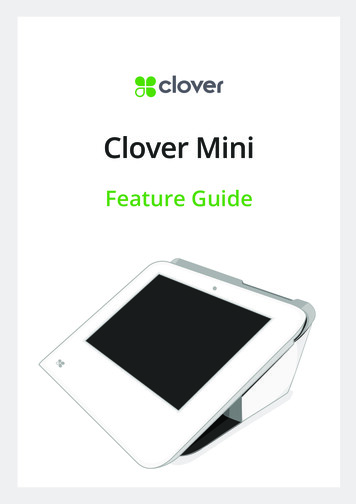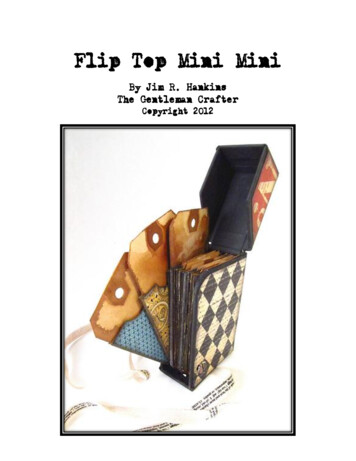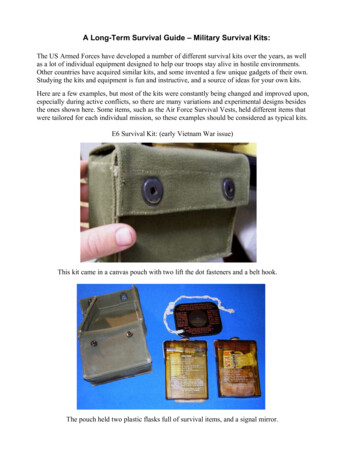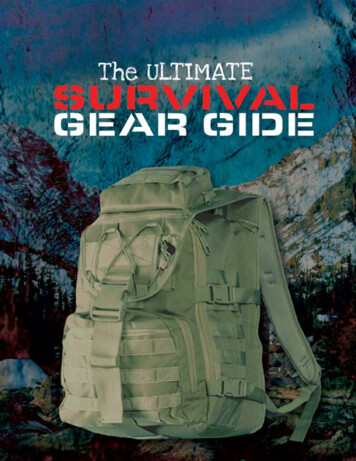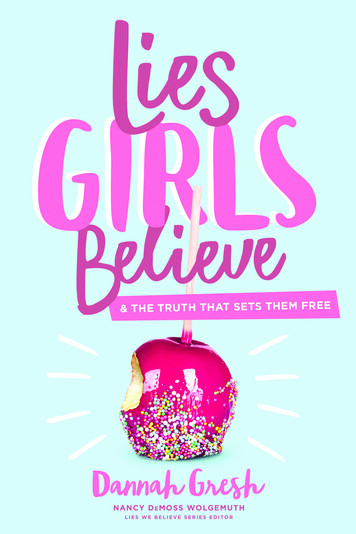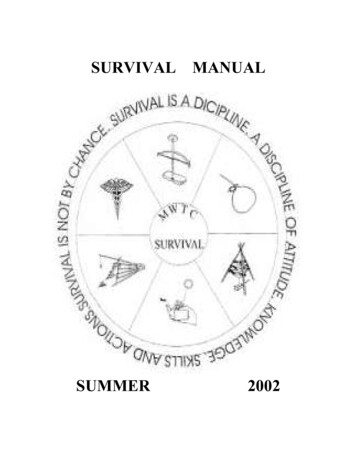
Transcription
Survival Mom's Mini Guide:Declutter and Organize YourLiving SpaceBy The Survival Mom, Lisa Bedford
NOTE: This book contains links to certain articles and other information available on the Internet. Theauthors have included these links as sources of information to help readers learn more about homeorganization.Please do your own research on any skill, product or advice before trying, buying, or relying on it,especially in an emergency. Links are included for educational, informational and entertainmentpurposes only, and are not intended to, nor should they be used to, replace applicable medical orother expert or professional advice.As of the date of publication, the links are to information that is believed appropriate to the subject matterof this book. However, due to the nature of the Internet and the third party control of links and linkedinformation, there is no guarantee that any links or the information that they reference have not changedsince publication, or that they will not change in the future. If you find erroneous or inappropriate links orinformation, please email admin@thesurvivalmom.com.The author is not responsible for linked online content, information, advice or products, and doesnot express or imply any endorsement thereof.Copyright 2015 by The Survival Mom (TM).Thank you for downloading this e-book. You are welcome to share it with your friends. This book may bereproduced, copied and distributed for non-commercial purposes, provided the book remains in itscomplete original form. If you enjoyed this book, please return to your favorite e-book retailer to discoverother works by this author. Thank you for your support.All rights reserved, including the right to copy, reproduce and distribute this book, or portions thereof, inany form, except as specifically relinquished in the immediate preceding paragraph.
Introduction“Into each life some rain must fall,” my mother used to tell me. I’ve found that to be true, but even moreso, “Into each life some clutter must fall.”For many years my life was ruled by clutter. With 2 young children, I somehow managed to raise them,homeschool them, and run a busy home-based business, but it wasn’t easy. Looking back, it wasn’t thetasks themselves that were difficult but the fact that I was living in a continual state of chaos that gave meheadaches nearly every day.In 2009, my husband and I toyed with the idea of moving to another city. We brought in a realtor, whoquickly suggested that I declutter my home to make it more appealing to potential buyers. That began myjourney of decluttering, which ultimately resulted in freeing me from the bondage of stuff. Stuff thatdidn’t really have a place, stuff that I clung to out of sentimentality, and stuff that had become a part ofthe landscape, and it never occurred to me to get rid of it!Now, almost 5 years later, my home is a far more peaceful place. It’s easier to keep clean, easier toorganize, and I know where to find whatever I need, when I need it!There’s a lot of freedom in owning less and then, organizing what you own. The process isn’t a quick one,but the journey is worth it.Lisa BedfordThe Survival Mom
Table of ContentsIntroductionTable of ContentsGetting Started Toward a Life Free of ClutterGet Your Home’s Key Areas Tidied UpKitchenThe Bedroom and Your WardrobeBathroomLiving RoomKids and Kids’ RoomsExtra ResourcesCreative Storage IdeasConclusionAbout The Survival Mom
Getting Started Toward a Life Free of ClutterEver have trouble finding something you needed because you couldn’t remember where you put it orbecause it’s buried under so much other stuff? Or, even worse, you bought something you thought youneeded, only to discover later you had purchased a duplicate?! When things like that happen, you knowit’s time declutter and get organized.Your home may not be entirely chaotic, but if you’re like most people, there is that one closet, that onedrawer that you don’t want to deal with because of the clutter inside.One of the main benefits of tackling that one closet, that one drawer, that one room, or the whole house isthat having those spaces organized will actually give you more time as you make use of your time andspace more efficiently. This frees you to enjoy life more and to focus on bigger plans and goals moreeffectively.If one of your goals is to be better prepared for emergencies or worst case scenarios, a living space that isorderly and with routines in place will be exactly what you need when a crisis arises.Whatever has nudged you to get your living spaces decluttered and organized, the big question is, whereshould you start?At this point, a lot of us immediately run to The Container Store or Walmart, anywhere with attractivestorage containers and get all excited about coordinating pretty colors and patterns! But actually, yourvery first step should be decluttering, and this isn’t an easy step because, primarily, it’s a process ofmaking decisions. Dozens, or even hundreds of decisions.You likely have many items that aren’t useful anymore. They may be worn out, they’re in sizes too big ortoo small or they haven’t been a part of your everyday life in a long time. Whatever the reason, they nolonger suit your needs. Identifying and separating those items from what you do want and do use is thefirst step toward clutter-free sanity.Choose a room or even a single drawer or cupboard and plan a path through your home. To stay on trackand motivated, make a list of every room in your home and put them in order based on which you willtackle first.You might choose to start with the entrance because it’s small and clearing it out will help you feel likeyou’ve made progress or because it’s the first thing guests see when they walk into your home. You coulddecide to start on the kids’ rooms because you are afraid something is living under the bed, or becausethey’ve moved out and it’s time to repurpose the room. If you’re feeling very overwhelmed, start with theleast messy and cluttered spot in the house. Getting that into ship-shape will help you feel like tacklingthe next biggest mess.There is no wrong place to start.Now you’re ready to get organizing!First, set some ground rules:1. As you work through your list, focus on one small area of that room at a time. That might be onedrawer or a counter-top. Plan on working in this one room for several days, or longer. You’rebetter off cleaning out half of a closet and finishing it a day or two later than just randomlyattacking an entire room! The key is to build one small success on top of another.2. Finish each area before moving on to the next. Leaving lots of half-finished tasks and looseends to tie up later will only frustrate you in the long run, and will make your home seem even
more disorganized and cluttered. You want to have areas that are completely finished so you canenjoy the progress you’ve made.3. Part of the process will almost certainly be moving things into another area where they actuallybelong. For example, if you’re working in a child’s room, you’ll likely find things that belong inthe kitchen, bathroom, or family room. Set those aside in a separate area or even in a bin or boxuntil your allotted organizing time has ended. Then put every misplaced item in its correct places.4. Give yourself a specific time frame, such as one area per day or per weekend. Setting a deadlinegives you an incentive to prioritize and clear the time you need. Make it official and block off thetime on your calendar. Stick with your allotted time. Decluttering and organizing isn’t the mostenjoyable task, so once your time is up, pat yourself on the back, tell yourself you’ll finish uptomorrow, and then move on.5. Take a few minutes each day to make sure the areas you already organized stay that way. It’s fareasier to put away half a dozen items than let it build up over time and you’re faced with anothercluttered mess!As you go through each space, most experts recommend that you:1. Cut through the unnecessary items that might have accumulated and the things that don’t work.Even if you only get rid of one item out of a crowded bookcase, that’s one less book, and it willprobably make it easier to get rid of other items that aren’t useful anymore.2. Promptly, get rid of what you don’t need. Rather than let it all accumulate in the garage orbasement until you find the time to get rid of it for good, sort items into garbage bags or donationboxes and get them gone as soon as you are finished with each area.3. If you plan on selling some items, make sure the return is worth the effort and be sure you’llactually be able to do it reasonably soon. Then decide how/where you want to sell them, and set adeadline for yourself. Enlist help and start immediately. If you are having a yard sale, price theitems as you go. Just put stickers on them or group them in boxes by price. If you are selling themonline (Craigslist, eBay, Amazon, etc.), take pictures right away. Better yet, find packagingsupplies for them and list them online immediately. Unlike a yard sale, online sales don’t requireyou to put everything up for sale at once. If you take the time to do this after you finishorganizing each area, it won’t be overwhelming.4. Determine how to best organize what’s left by grouping items by type and frequency of use.Items that are used the most frequently should be the most accessible. Reserve less convenientstorage areas, such as top shelves or hard to reach corners, for items that you need and will use,just not very often.5. Determine how to make all areas as accessible as possible. For instance, do you need a stepstool handy to be able to reach the top shelf more easily? Would a lazy susan in the cabinet helpminimize “losing” items and cut out the need for rummaging in that hard to reach corner?Keep reading for more tips and links to articles with more ideas and some great books to help you getyour game plan ready!Recommended Articles100 Ways to Get OrganizedBest Organizational and Decluttering Websites List at Apartment Therapy100 Ways to Get Rid of ItRecommended Books31 Days To a Clutter Free Life: One Month to Clear Your Mind, Home, and Schedule by RuthSoukup
Simplify Your Space: Create Order and Reduce Space by Marcia RamslandOne Year to an Organized Life by Regina Leeds
Get Your Home’s Key Areas Tidied UpOnce you have a game plan for decluttering and organzing your home, it’s time to put it into action! Youmay wish to focus on the areas of your home you use the most, to give yourself an immediate sense ofaccomplishment. I’ve outlined five areas of the home that are high-traffic areas and clutter magnetsfor most families: kitchens, bedrooms, bathrooms, living rooms, and kids’ rooms.We’ll take a look at tips and strategies for each area, and offer a few suggestions on products and otherresources to help you get the job done.
KitchenNot only is the kitchen the place where most of us prepare and enjoy our meals, it’s also often the stagingarea as we start our day, and where we sort our mail, pay our bills, and go through coupons andschoolwork.Kitchen counters are easily one of the most problematic clutter magnets in the house. For a dramaticorganization boost, clear them off and keep them clean. Find permanent homes for items in drawers orcabinets if they are kitchen essentials. If not, banish them to their appropriate rooms in the house.SURVIVAL MOM TIP: I use trays of different sizes to keep items together and in the areas inwhich I need them. For example, next to my stovetop, I have a small white ceramic tray thatholds salt, pepper, and bottles of olive oil and coconut oil. Visually, this is far more appealingthan these 4 items placed randomly on my countertop. On my kitchen table, there is another traythat holds coasters, napkins, and salt and pepper shakers. Each tray gives these small items ahome, and it’s been easy to train my husband and kids to always put things back on their assignedtray!After the counters are clean, create a handy Command Station to keep paperwork and schedulesunder control. Stock it with a family calendar that’s easy for everyone to read, and add a different colorpen for each family member to make it easy to see at a glance who is doing what, when. Post a notepadfor an ongoing grocery list to help cut down on trips to the store. Add a mail sorting rack to keep mail offthe counters and bills in one place. Some racks even have hooks so you never need to wonder where youleft your keys.If your kitchen has a built-in desk area, go wild and actually use it as as desk! Establish that area as yourhome’s Command Station with all the related items together there.Another area to declutter and organize will likely be your cupboards that hold food and your pantry.Throw away expired items. Donate items that aren’t expired but you know you will never eat to a localfood pantry. That includes ones that no longer fit your diet, things the kids loved but now refuse to eat it,and anything that looked good at the store but now looks unappealing. Food pantries cannot accept or usefood with expired dates.When organizing the food in your cupboards and pantry, consider grouping items by use. For example,have a designated shelf or area for coffee, tea, and drink mixes; a designated shelf for baking necessities;or an easy to reach cabinet with healthy snack options so kids can help themselves after school. Thenlabel them so everyone else can find them and put them back in the right place.The spice cabinet can be another problem area in the kitchen. You may not go so far as to alphabetizeyour spices, but at least make sure everything is easier to find by using a turntable or stair step spice racksthat make it easy to read labels without needing to rummage. The spices you use most frequently shouldbe the most accessible.Kitchen drawers probably come in a close second to counters as far as attracting the most clutter. I usethese expandable bamboo drawer organizers to keep my kitchen tools and flatware organized.Who doesn’t have a junk drawer (or two) in their kitchen? After the counters are clean and the pantry istaken care of, turn your attention to the drawers. Banish that junk drawer!Instead, determine what, exactly, needs to be in that drawer. Small hand tools? Pens and pencils? A fewnotepads? All these can be organized using small boxes within the drawer. While you’re going throughthis messy pile, sort like things together, and look for:
Pens and markers that have dried out. Throw them away.Pencils with broken tips. Sharpen them and replace in the drawer. Be sure to have a small pencilsharpener with them. Anything that is almost empty or used up, including bottles of glue and rolls of tape. Tiny items that can be stored in a Zip-loc bag, empty Tic-Tac box, or similar containers, likepaperclips, safety pins, and push pins. Get these sorted into separate containers, and then backinto your drawer. Sentimental items that aren’t junk at all and should be stored somewhere else. Multiples of items when you only need to have 1 or 2 in the drawer, such as scissors or Post-itnotes. Those extras can go to other places in the house where they might be needed or placed inthe Donate box for charity. Things you used and then put in the drawer rather than putting them back where they belong.When placing smaller organizing boxes in this drawer, think of it as a jigsaw puzzle and find boxes ofdifferent sizes and shapes to provide a place for each category, according to how they were sorted.Desk supplies can be neatly incorporated into the Command Station. Tools should go into the tool box,etc. There are many organizers available to make organizing your other drawers a snap. Be sure to takemeasurements so you know the organizers will fit in the drawers.Recommended Articles60 Innovative Kitchen Organization and Storage DIY Projects8 Smart Organizing Ideas for the Kitchen from TidyMom.net14 Easy Ways to Organize Small Stuff in the KitchenRecommended BooksThe Organized Kitchen by Brette Sember1001 Ideas for Kitchen Organization by Joseph ProveyKitchen Organization Tips and Secrets by Deniece Schofield
The Bedroom and Your WardrobeA long-standing, tried and true rule for bedroom organization and cleanliness is to make your bed everyday. Establishing that single habit gives your room a sort of I’ve-got-things-under-control feeling. Even ifyour dresser drawers and closet are chaotic, when they’re closed, your room will still look and feelpeaceful.Maximizing under-bed storage can be a great strategy for gaining more useful space in thebedroom. Obviously, this needs to come a long way from when you threw everything under the bed as akid when your mom told you to clean your room. Under-bed storage bins and baskets are a must to makethis option work. These bins come in either plastic or canvas, and are a great place for extra blankets,winter clothes, shoes, or anything else you want to be accessible but out of the way. Depending on thestyle of your bed, you may even be able to purchase risers to give you a few more inches of space forboxes and baskets.If you enjoy reading in bed, you may want to keep your books, magazines, and personal reading lightshandy with a caddy that hangs by the bed. A bedside table is the perfect place for a tray that holds readingglasses, tissues, and even an alarm clock.Organizing dressers can be daunting. Try devoting drawers to a single type of clothing item, such asshirts or pants. You may need to experiment with how you fold your things. With some items, rollingthem allows you to find your items more quickly. Others are nearly impossible to fold, particularly smallor silky items, and need drawer dividers. Still others are simply too bulky or unwieldy to roll and mightbe better in the closet.SURVIVAL MOM TIP: I’ve taught my kids to organize their drawers from top to bottomaccording to how they get dressed. Their top drawer holds underwear, undershirts, socks, andbras. The middle drawer holds shirts and tank tops and the bottom drawer holds shorts and pants.This system is very easy for them to remember.JewelryOrganizing jewelry and other small items like shirt stays and scarves can be challenging. As witheverything else, the first step needs to be getting rid of anything you don’t use. If you look at a pieceof jewelry and immediately feel scratchy because that piece scratches every time you wear it, just let it go.If you have 15 pairs of studs but rarely wear them, you know what to do.Put anything damaged to one side in a separate container. You may be able to repair some of it, but set atime limit for yourself to fix it or get rid of it. Put anything that needs cleaned to the side as well. You canpurchase an inexpensive sonic cleaner but read the instructions carefully. It’s great for cleaning silver andlot of other jewelry, but it can destroy fragile jewelry like opals and emeralds. Force yourself to clean itwithin 24 hours because, really, there is no excuse for not doing it.Once you have narrowed down your jewelry stash, it’s time to start organizing and putting things away.First of all, make sure you actually like the jewelry boxes or containers you are putting things back intobecause you will probably be looking at them every day. I used a jewelry box for a decade beforeadmitting that I had never liked it (it was a gift) and got rid of it. I love my other jewelry boxes and justlooking at them makes me happy.Evaluate where you keep your daily use jewelry. Maybe leaving it on the bathroom counter is OK, butmaybe that doesn’t work any more. If you don’t already have a ring tree, consider picking one up (ormakig one) to keep your rings relatively safe but still handy. (It makes a great arts and crafts activity,especially with clay.) If you are like me and have slowly acquired an entire watch wardrobe, it might be
time for a watch box. Just be sure you are buying something you will truly use and need, not just addingclutter you’re going to need to get rid of next year.ClosetsIf you are like many other people, your closet is crammed so full of clothing it feels like a workout topull out or put back a single item. Realistically, how many of those items do you wear? If you don’twear them, why are you keeping them? It’s OK to have a few special items that you rarely wear, but ifyou have more than two or three, rethink why you’re keeping so many.If you need dress up clothing so rarely that your only “dress up” dress hasn’t been worn in 8 years, thenyou should probably just treat yourself to something new (and in style, that flatters your current shape andhair style) the next time you need to dress up.Don’t forget to go through your shoes. Those goes-with-everything dress shoes you love may not go withyour newish bunions, and your favorite hiking boots may be dry-rotting.The standard advice is to get rid of anything you haven’t worn in a year. Personally, I make an exceptionto that rule for anything I truly love that is still in good condition that I’m just tired of right nowbecause I've worn it so much. I put those few items to the side for a year or two and, much like hiding asmall child’s toys, it’s like it’s new again when I pull it out.If you have more than ten items for the whole year - all four seasons - that you think fall into thatcategory, you are almost certainly keeping too many. You’ll also need to be very sure they won’t lookdated. My peasant skirts, wool dress coat, and rugby shirts all fit into the timeless category.As a prepper, you may also have a virtual second wardrobe of items you can use if everything falls apart.You still need to go through that second wardrobe. Make sure it all still fits. If you find you have 25 shirtsand two pairs of pants and seven wool socks (not pairs, socks), then you have identified a some problemareas to address.You also need to check for moth or other damage. If clothing really is stored for the long-term, thenyou need to store it for the long term, complete with mothballs, a cedar chest, or whatever that specificitem needs.SURVIVAL MOM TIP: Have you heard of the 80/20 Rule? It’s astonishing how often this ruleis proven true in a variety of scenarios. Applied to clothing, it states that 20% of the clothes youown, you wear 80% of the time. That means that you could likely get rid of 80% of what is inyour closet and drawers and not even miss it, since you might wear them 20% of the time, or less.Of course you’ll want to hold on to winter wear and bathing suits, since you need them even ifonly seasonally. But keep an eye on what you wear most often and see if it’s not just about 20%of what you own and you likely wear those things 80% of the time!Recommended Articles20 Ways to Organize Your BedroomQuick Tips for Organizing the BedroomRecommended BooksThe Tidy Closet: Tips From A French Woman: Easy Steps And Motivation To Declutter YourCloset And Organise Your Wardrobe by Marie-Anne LecoeurHow To Organize Your Life At Home - Closets (How To Organize Your Life At Home Series Book1) by Maya Sheppard
BathroomIn the bathroom, the medicine cabinet is often stuffed full of. . .stuff. There’s a jumbled mess that falls outwhenever you open the door. To get started decluttering and organizing this small space, dump everythinginto a box and sort out whatever is broken, expired, useless, or doesn’t belong.Next, consider ways to maximize space. If you can adjust your shelves, move them to make room for thetallest items on the bottom shelves. Use the middle shelves for the most-used items. Give occasionaluse items a home on the top shelf. Organize small loose items like tweezers and nail clippers in a smallzipper pouch or a small cup where you can easily find them when they are needed.Bathroom drawers should be sorted and organized in a similar manner to kitchen drawers. I use thesesmall bamboo boxes to hold jewelry, contact lens cases and solutions, lip balms, and the essential oils Iuse most often.Don’t forget to purge items you don’t need from the drawers! That includes appliances like your hairdryer and curling iron. If you no longer use them or they no longer work right, give them away or throwthem out.Clear plastic shoe boxes make the perfect storage solution under the sink. They can be used to organizeextra soap and toiletries, or one can be assigned to each family member to keep the counters clutter free.A caddy under the sink can be used to organize cleaning supplies so that chores are easier.SURVIVAL MOM TIP: Splurge, go crazy, and have a separate caddy of cleaning suppliesbeneath the sinks of each bathroom! When I have to go hunting for glass cleaner, a sponge, orwhatever I need to start a cleaning job, I’m invariably sidetracked by laundry, phone messages, ora thousand other things. When all my cleaning supplies are right where I need them, when I needthem, the task actually gets done! (I also have a toilet bowl brush and plunger in each bathroom.)Keeping extra toilet paper handy and out of sight can also help the bathroom feel less cluttered.Decorative canisters designed specifically for the job can fit in the tight space next to the toilet that isotherwise wasted, or you can opt for an extra-large, decorative desk file or magazine organizer- as long asit is 8” wide it should easily accommodate toilet paper rolls and still fit neatly beside the toilet.Decorative baskets placed on the back of the tank or on the floor are another option. I considerhaving extra rolls of toilet paper within reaching distance of the toilet a must!In the shower and bathtub, try using a shower caddy that hangs from the shower head to keep shampoosand body wash in one place. If you have a shower (no tub), try a floor caddy. (The rounded sides of abathtub mean they don’t work well in a shower/tub.) If you have kids and need a solution for bath tubtoys, a basket that fits across the tub or mesh bag can keep things within easy reach but organized andable to drip-dry.Recommended ArticlesStore More in Your Bathroom43 Practical Bathroom Storage Ideas20 Creative Toilet Paper Storage IdeasRecommended BooksBedroom and Bath Storage: How to Plan & Organize, Closet Systems, Space-Saving Ideas bySunset Books
Home Decluttering and Organization - Volume 2: Bathrooms Angela Russ
Living RoomThe living room or den gets a bad rap for organization because it can be the stage for so many differentactivities. Try organizing your room by activity. Don’t be constrained by the label on the floor plan ofyour home - base it on what YOU do or can use it for. If your family will always use the eat-in kitchenand not the formal dining room, go ahead and turn it into a TV room or office! Heck, turn it into awrapping room if you’ll use it more that way!If you read a lot, create a reading nook with books out of sight behind cabinet doors, or try organizingthem by subject. Group movies and gaming systems together neatly in an entertainment center. Developstrategies for other areas of the living room, such as a desk where children can do homework, or a way tostylishly organize yoga mats, weights, and resistance bands, if your living room is also your home gym.DVDs and CDs can take up an enormous amount of space, but if you toss the cases, you can opt forsomething much more organized: a portable binder that holds the discs in individual pockets so you caneasily find whichever movie you’re looking for. If you don’t want to throw away the cases, you can stillget organized with a DVD tote that can be stored behind the couch or in a cabinet of the entertainmentcenter. If you really have a lot of DVDs, you can buy a specially sized bookcase. (It will also fitpaperback books nicely.)If it feels like the gaming systems are taking over this room, get the wires under control first withsomething like Captive Cables. As you do this, take the labels from bread and use them to label whichdevice each cord goes to. You need to do that for the power cords and the video cords going to the TV.A small game system organizer can help if you only have one game system and a few games to organize,but if there is a diehard gamer in your family, you may be better off giving them their own station. Eitheroption will create designated places for gaming systems, games, and controllers. Or, you may want toplace a small basket on a coffee table or end table to catch remote controls for everything from the TV,DVD player, and game controllers all in one place.Recommended ArticlesOrganizing Your Living RoomRecommended BooksKids & Their Clutter: Practical Minimalism for Challenging Messes (Practical Minimalism BookSeries 3) by Faith JanesClutter-Free With Kids For New Parents: De-Clutter and organize your home with 7 easy tofollow steps - Feel better instantly by Dr. Michael Smith
Kids and Kids’ RoomsMore than any other room in the house, children’s rooms present the most challenges for gettingorganized and staying organized.As a first step, you may want to consider downsizing the toy collection. Look for broken toys, or toysyour children have outgrown. Keep in mind the 80/20 Rule. It applies to toys, too!Next, consider leaving out only a portion of your child’s toys at any one time. Toys can be rotated in andout of more permanent storage (like a box in the basement, attic, or closet) to help manage clutter and sothat the kids don’t get bored with them as easily.Once the toys have been sorted, look for inexpensive storage solutions to get a jumpstart on organizing.Try hanging a shoe holder on the back of the door or on a wall to provide instant storage for small toys. Ifyour child has a large stuffed animal collection, try a hammock to keep them all corralled. Inexpensivestorage cubes and soft baskets are also great.In a kid’s rooms, making furniture pull double duty as storage is always a plus. Stay away from largechests or trunks that might tempt kids to play inside them, and instead focus on smaller ottomans orbenches with cubbies.Once the initial ground rules a
your game plan ready! Recommended Articles 100 Ways to Get Organized Best Organizational and Decluttering Websites List at Apartment Therapy 100 Ways to Get Rid of It Recommended Books 31 Days To a Clutter Free Life: O
